Writing the APUS DBQ Daniel W Blackmon Coral

Writing the APUS DBQ Daniel W. Blackmon Coral Gables Sr. High School

APUS DBQs vs. APEH DBQs AP European History DBQ’s have a very different philosophy from AP United States History DBQ’s. Everything you learned in writing DBQ’s in APEH is useful in APUS. But you must understand the differences in order to score well in APUS.

Good News! All of the essay writing skills you have learned up to this point still apply. A DBQ is an essay. The difference between a DBQ and a Free Response Question is simply (!) that you have to use the documents in order to answer the question.

Bad News! You have limited time to read, interpret, and organize the use of your documents. Writing a DBQ in 1 hour is the most difficult task you will be set in APUS.

What is a Document Based Question? This portion of the AP examination in history is the essay which tests the student’s ability to evaluate historical documents (primary sources).

What is a Document Based Question? Students are given a series of primary documents with a following question.

What is a Document Based Question? . In most cases, the question will ask the student to “discuss, ” “analyze, ” and / or “evaluate” the question using the documents.

The DBQ The required DBQ differs from the standard essays in its emphasis on the ability to analyze and synthesize historical data and assess verbal, quantitative, or pictorial materials as historical evidence.

The DBQ Like the standard essay, however, the DBQ will also be judged on its thesis, argument, and supporting evidence.

The DBQ Although confined to no single format, the documents The required DBQ differs from the standard essays in its emphasis on the ability to analyze and synthesize historical data and assess verbal, quantitative, or pictorial materials as historical evidence.

The DBQ Like the standard essay, however, the DBQ will also be judged on its thesis, argument, and supporting evidence. contained in the DBQ are unlikely to be the familiar classics (the Emancipation Proclamation or Declaration of Independence, for example), but their authors may be major historical figures

The DBQ The documents vary in length and are chosen to illustrate interactions and complexities within the material.

The DBQ The material will include—where the question is suitable—charts, graphs, cartoons, and pictures, as well as written materials.

The DBQ In addition to calling upon a broad spectrum of historical skills, the diversity of materials will allow students to assess the value of different sorts of documents.

The DBQ will typically require students to relate the documents to a historical period or theme and, thus, to focus on major periods and issues.

The DBQ For this reason, outside knowledge is very important and must be incorporated into the student's essay if the highest scores are to be earned.

The DBQ It should be noted that the emphasis of the DBQ will be on analysis and synthesis, not historical narrative.

The APUS Philosophy In addition, the student in APUS is required to utilize their knowledge of the historical period in the evaluation process.

The APEH Philosophy In APEH, the student need not bring outside information to the interpretation of the documents. APEH DBQ’s can therefore be much more specialized, focusing on topics such as Sale of gin in 18 th century England (1988) or Child Rearing Practices in the 16 th-18 th Centuries (1982)

The APUS Philosophy APUS however, must choose topics that are part of the main line of US historical development, such as Labor Unions in the Gilded Age (2000) or Jacksonian Reform Movements (2002).

The APUS Philosophy Otherwise, students could not reasonably be expected to provide outside information.

General Principles for FRQs As is the case with any writing, you need to be aware of the purpose and the audience.

Sample Essays Take some time to read the Rubric for the 2007 DBQ.

Sample Essays Now read the first three sample DBQs, and, bearing the rubric in mind, decide which paper is High, which is Middle, and which is Low.

Purpose Essays in Advanced Placement History are Expository Essays, That is, they are arguments whose purpose is to convince the Reader.

Purpose Do Not try to be stylistically creative! The results can be pretty humorous, but do not help you with the Reader!

Examples of False Creativity “The Iron Curtain, which created a blindfold on the US was now shedding an eye-opening wake-up call of light on the US. ” (APUS 2001)

More Examples of False Creativity Being drunk all the time was a social event that grew and grew. ” (APUS 2002)

More Examples of False Creativity “This time period was STUFFED full of reform. ” (APUS 2002)

More Examples of False Creativity “Fuller, Emerson, and Thoreau were noted transvestites. ” (APUS 2002)

More Examples of False Creativity “The Temperance Movement founded the American Bar Association. ” (APUS 2002)

More Examples of False Creativity “People were starting utopian societies like the Oneida society and Brook Farm, wehre some of America’s greatest writers went to explore nature and become “transparent eyeballs. ” (APUS 2002)
![More Examples of False Creativity [from the same student] “This shows their motivation as More Examples of False Creativity [from the same student] “This shows their motivation as](http://slidetodoc.com/presentation_image_h2/1af9ea1e519debba2c9de43445bda538/image-33.jpg)
More Examples of False Creativity [from the same student] “This shows their motivation as being their own selfish gain because no one can deny the incredible high acquired after doing a good deed, not to mention that good deeds look well on your transcript after one dies. ” (APUS 2002)

The Moral of the Story It is not good when the Reader stops to share your paper with a neighbor or write down you keen insights!!!

The APUS 2007 DBQ I will be using the APUS 2007 DBQ, on US Agriculture in the late 19 th century, as my example.

APUS 2007 DBQ Each of you should have a copy of the DBQ as well as a copy of the Rubric and other materials. You should refer to them as we go through this Powerpoint.

Rule Number One Answer the question that has been asked!!!!!! (As opposed to the question you only wish they had asked!!!!)

Rule Number One Underline the tasks demanded and the terms which are unique to the question. Underline the time frame of the question!

Rule Number One Analyze the ways in which technology, government policy, and economic conditions changed American agriculture in the period 1865 -1900. In your answer be sure to evaluate farmers' responses to these changes.

Rule Number Two Make sure you understand what the question requires of you!

Rule Number Two If the question asks you to evaluate something, but you only describe, you cannot write a satisfactory answer.

Note the use of key terms: Analyze: determine their component parts; examine their nature and relationship.

Note the use of key terms: Assess / Evaluate: judge the value or character of something; appraise; evaluate the positive points and the negative ones; give an opinion regarding the value of; discuss the advantages and disadvantages of.

Note the use of key terms: Compare: Examine for the purpose of noting similarities and differences.

Note the use of key terms: Contrast: examine in order to show dissimilarities or points of difference.

Note the use of key terms: Describe: to give an account of; to tell about; give a word picture of.

Note the use of key terms: Discuss: talk over; write about; consider or examine by argument or from various points of view; debate; present the different sides of.

Note the use of key terms: Explain: make clear or plain; make clear the causes or reasons for; make known in detail; tell the meaning of.

APUS 2007 Analyze the ways in which technology, government policy, and economic conditions changed American agriculture in the period 1865 -1900. In your answer be sure to evaluate farmers' responses to these changes.

Key Terms and Tasks Technology Government Policy Economic Conditions Farmer’s responses Change over Time (COT)

Key Terms and Tasks Analyze Evaluate

Organizing The Essay In this example, your subtopics are specified.

Organizing The Essay With other essays, the question is left more open ended, without specifying the subtopics: Example: "Reform movements in the United States sought to expand democratic ideals. " Assess the validity of this statement with specific reference to the years 1825 -1850.

Organizing The Essay One very useful tool for analysis is the PERSIA concept: separate your observations into categories for analysis using an acrostic:

Organizing The Essay P = political E = economic R = religious S = social I = intellectual A = aesthetic

Organizing The Essay In the case of the 2002 DBQ, ask yourself if there is a Political dimension to “democratic ideals? ” Is there an Economic dimension? Is there a Religious dimension? Is there a Social dimension?

Organizing The Essay From that starting point, you can begin to group your documents according to those dimensions.

Organizing The Essay In the case of the 2007 DBQ, you already know that you need to group the documents with respect to: Technological change Government policy Economic conditions Farmers’ responses

Organizing The Essay Note: Grouping your documents by subtopic helps you in two important ways: First, your essay is organized analytically rather than descriptively, which is always good. Second, it helps avoid using the documents in alphabetical order, which is always bad.

Grouping Documents: APUS 2007 Document A: Agricultural Prices (Economic conditions) Document B: Railroads in 1870 and 1890 (Technology)

Grouping Documents: APUS 2007 Document C: Prairie Farmer July 14, 1877 (Government policy, Farmers’ Response) Document D: The Wheat Harvest (Technology, Economic conditions)

Grouping Documents: APUS 2007 Document E: A Contract in North Carolina (Economic conditions, Farmers’ Response) Document F: Harper’s New Monthly Magazine (Technological changes, economic conditions)

Grouping Documents: APUS 2007 Document G: Speech by Mary Elizabeth Lease (Economic conditions, Government policy, Farmers’ response)

Grouping Documents: APUS 2007 Document H: Susan Orcutt to Lorenzo D. Lewelling (Government policy, Economic conditions, Farmers’ response) Document I: R. W. Mc. Adams, Oklahoma Magazine (Government policy, Farmers’ response)

Grouping Documents: APUS 2007 Document J Speech by William Jennings Bryan (Government policy, Economic conditions, Farmers’ responses)

Rearrange by Subtopic: Technological Change Document B Document D Document F

Rearrange by Subtopic: Government Policy Document B Document C Document G Document H Document I Document J

Rearrange by Subtopic: Economic Conditions Document A Document C Document D Document E Document F Document G Document I Document J

Rearrange by Subtopic: Farmers’ Response Document C Document D Document E Document G Document H Document I Document J

Step Three: List Useful SFI Make a quick list of factual data that might bear on the question. Group them according to the sub-topics

Step Three: List Useful SFI pertinent to Document C Farm Cooperatives Farmers’ Alliances (Northern, Southern, Black) Grange / Patrons of Husbandry Oliver Hudson Kelley Granger Laws Interstate Commerce Commission

Step Three: List Useful SFI pertinent to Document C Greenback-Labor Party Munn v Illinois Wabash case Swing / doubtful states

Step Three: List Useful SFI pertinent to Document E Crop lien Debt peonage Sharecropping Tenant farming Farmers’ Alliances New South

Step Three: List Useful SFI pertinent to Document G: “Raise less corn and more hell!” James B. Weaver Omaha Platform / Ocala Demands Overproduction / crop surpluses “Pitchfork” Ben Tillman

Step Three: List Useful SFI pertinent to Document G: Populists / People’s Party Tom Watson Ignatius Donnelly Greenbacks Greenback-Labor Party

Step Four: Read and Analyze the Documents Read analyze the documents. Read critically! Do not take everything at face value. Underline important statements, and make marginal notations.

Analysis of Document C: Document Information Farmers were dissatisfied with railroads The Illinois legislature passed laws limiting freight rates The Supreme Court upheld Illinois laws limiting freight rates Illinois was the only state with such a law

Analysis of Document C: Document inferences: Farmers sought state regulation of grain and railroad freight rates The Grange organized farmers Granger laws were enacted in Illinois The Supreme Court upheld Granger laws in Munn v Illinois

Analysis of Document C: Document inferences: Farmers had political clout in swing / doubtful states The Supreme Court subsequently ruled regulation of interstate commerce an “exclusive” federal right in the Wabash case Change from the laissez-faire philosophy of the early Gilded Age

Analysis of Document D: Document Information. Shows reaper / thresher (combine) harvesting wheat Shows need for large equipment and horses

Analysis of Document D: Document inferences: The application of technology to farm equipment increased production Grain farming was conducted on a large commercial scale.

Analysis of Document D: Document inferences: Availability of new technology led to farmers investing in heavy machinery and to the emergence of large scale commercial / bonanza farming Can be linked to Documents A and B to emphasize changes in agriculture and farmer responses

Analysis of Document H: Document Information The Orcutts are starving Hail ruined their crops No jobs can be had in 10 counties

Analysis of Document H: Document Inferences: Farming on the Great Plains was difficult The Homestead Act brought many people to the Great Plains Many homesteaders returned East because of the hardships they encountered The Panic of 1893 hurt farmers and led to poverty hardship, and widespread unemployment.

Analyzing Documents A fundamental skill with all DBQ’s is evaluating Point of View (POV) Everything you learned in APEH about expressing POV is applicable in APUS. Students who do not understand POV usually end up writing superficial, silly, or error filled essays!

Analyzing Documents An awareness of POV demonstrates a more sophisticated understanding of the documents than an answer that simply accepts everything at face value.

Analyzing Documents Unlike AP European History, the Reader is NOT counting the instances of POV. However, the Reader is very aware of the use of POV in an essay.

Analyzing Documents Aware of POV will probably not change the markband (High, Middle, Low) but it will move the score up within the markband.

Analyzing Documents Who or what at is the source of the document? What bias does the source have? What do you know about the source? What audience is being addressed, and how might that influence what is said?

Analyzing Documents Is the source a primary source (a letter, journal entry, speech, or contemporary cartoon, for example) or a secondary source (a historians' interpretation, a chart or graph).

Analyzing Documents How reliable is the document? Statistical charts are very reliable, but may not provide an explanation for the data. Primary sources often have a bias. The author of the document is frequently part of the controversy.

Analyzing Documents Note when one document apparently contradicts another. Why is this so? (For example, they may be written by individuals on opposite sides of a controversy,

Analyzing Documents Bias is inherent in all documents Another way of phrasing “bias” is to ask what mental filters the author of any given document uses to make sense of the world.

Analyzing Documents For example, Mary Elizabeth Lease obviously sees the world through the mental filters of a Western farmer. The contract from North Carolina reflects the mental filters of a land holder in the New South

Analyzing Documents The table of Agricultural Prices represents the mental filters of the historian who compiled the statistics. Any historian selects those data that he/she regards as significant, and ignores data that he / she does not regard as significant.

Analyzing Documents If you do not understand a picture, graph, or cartoon, then do not use it!

Analyzing Documents For that matter, if you are unsure of the meaning of ANY document, then do not use it!

Analyzing Documents Interpreting a document incorrectly will have a negative impact on your answer! I usually lower a mark by at least one point for the misuse of a document.

Analyzing Documents As you read, note which documents can be used with each sub-topic. In this way, you can group the documents effectively in your essay.

Step Five: Thesis Provide a clear, well developed thesis within a Thesis Paragraph that lays out the major sub-topics in your essay

Provide a Clear Thesis This is not Mystery History. Tell the Reader what you intend to prove, and how you intend to prove it.

Provide a Clear Thesis I am marking holistically, that is, I am evaluating the essay as a whole.

Why is Clarity a Virtue? In 2007, I spent an average of 1 minute, 30 seconds for each free response essay (250 / day)! For a DBQ essay, I slowed down to 2 minutes for each essay (200 / day)!

Why is Clarity a Virtue? My first decision is to place the essay within one of the markbands as described in the rubric, and only then will I refine it.
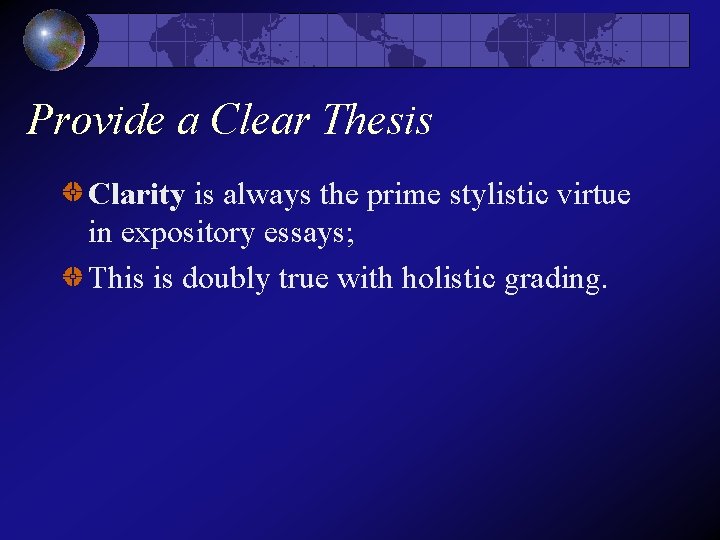
Provide a Clear Thesis Clarity is always the prime stylistic virtue in expository essays; This is doubly true with holistic grading.
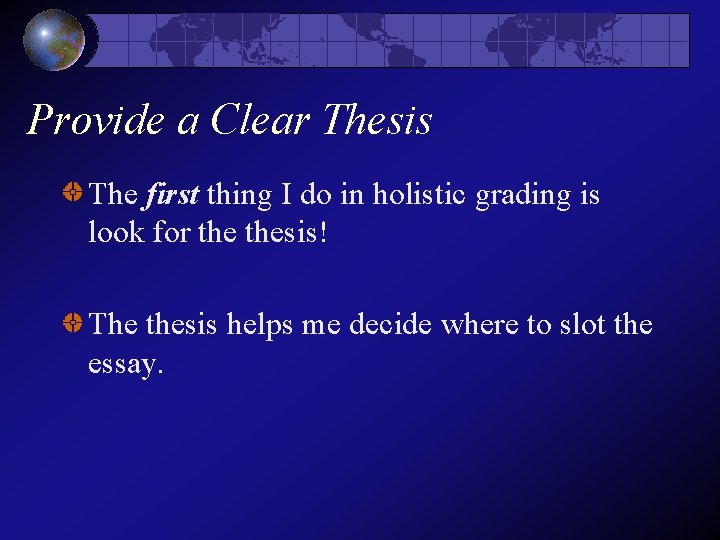
Provide a Clear Thesis The first thing I do in holistic grading is look for thesis! The thesis helps me decide where to slot the essay.

2007 APUS Rubric (excerpted) Markband 8 -9: “contains a well-developed thesis that examines the ways in which technology, government policy and economic conditions changed American agriculture between 1865 and 1900 and evaluates farmers’ responses to those changes. ”
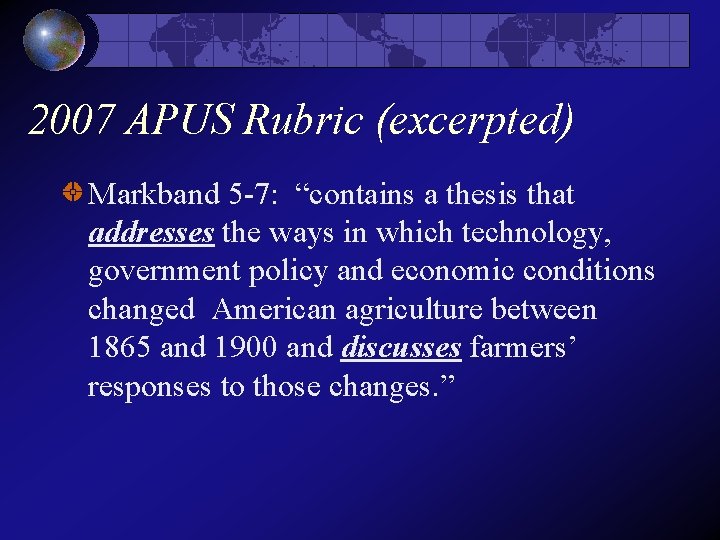
2007 APUS Rubric (excerpted) Markband 5 -7: “contains a thesis that addresses the ways in which technology, government policy and economic conditions changed American agriculture between 1865 and 1900 and discusses farmers’ responses to those changes. ”
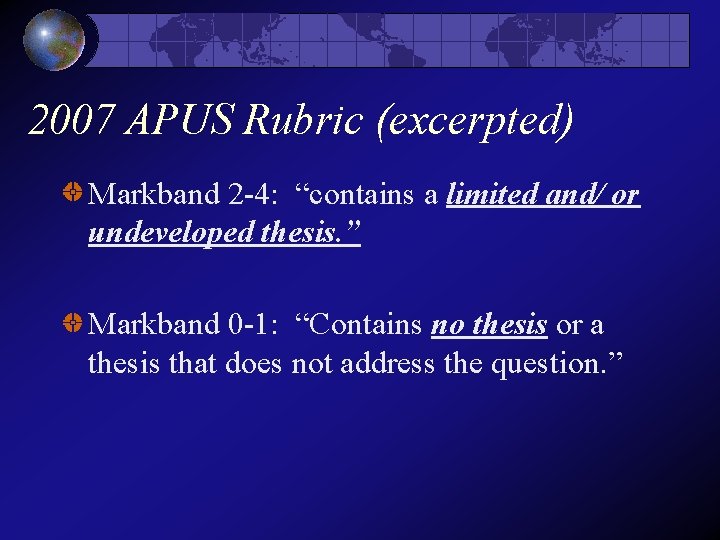
2007 APUS Rubric (excerpted) Markband 2 -4: “contains a limited and/ or undeveloped thesis. ” Markband 0 -1: “Contains no thesis or a thesis that does not address the question. ”
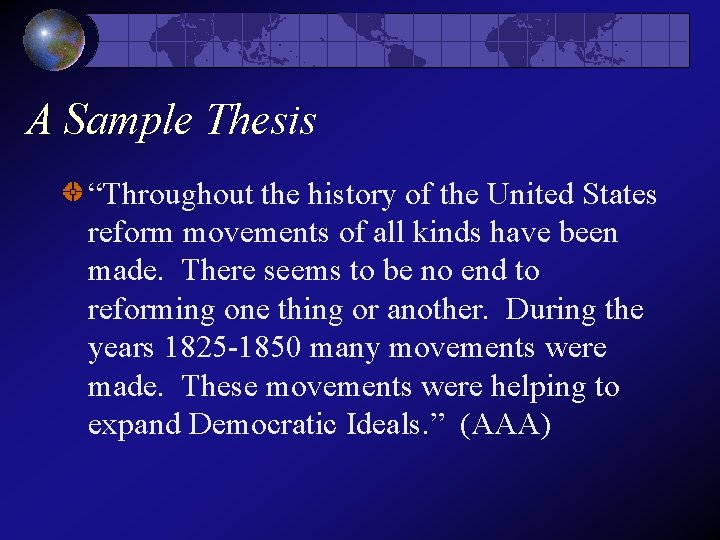
A Sample Thesis “Throughout the history of the United States reform movements of all kinds have been made. There seems to be no end to reforming one thing or another. During the years 1825 -1850 many movements were made. These movements were helping to expand Democratic Ideals. ” (AAA)
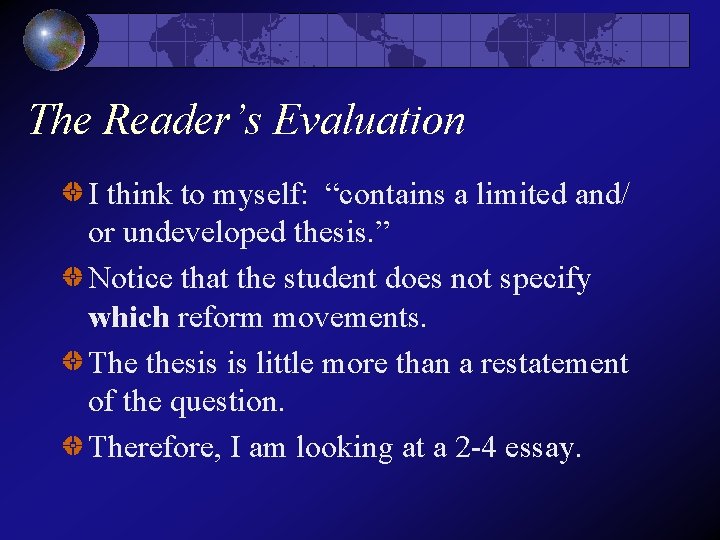
The Reader’s Evaluation I think to myself: “contains a limited and/ or undeveloped thesis. ” Notice that the student does not specify which reform movements. The thesis is little more than a restatement of the question. Therefore, I am looking at a 2 -4 essay.
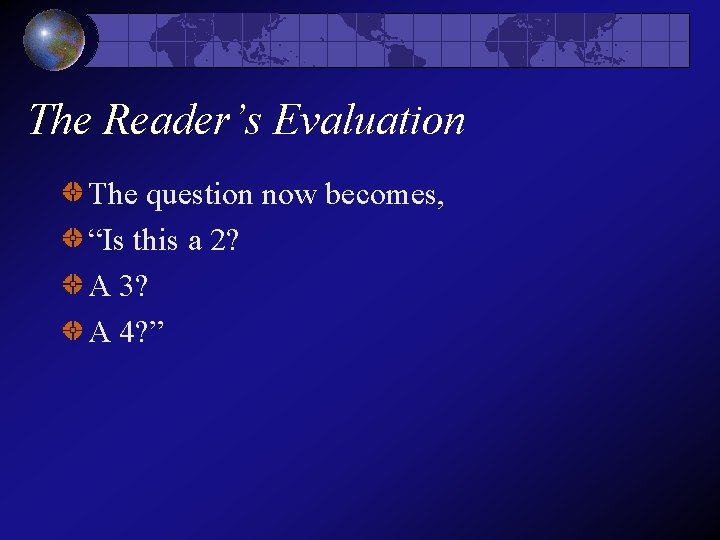
The Reader’s Evaluation The question now becomes, “Is this a 2? A 3? A 4? ”
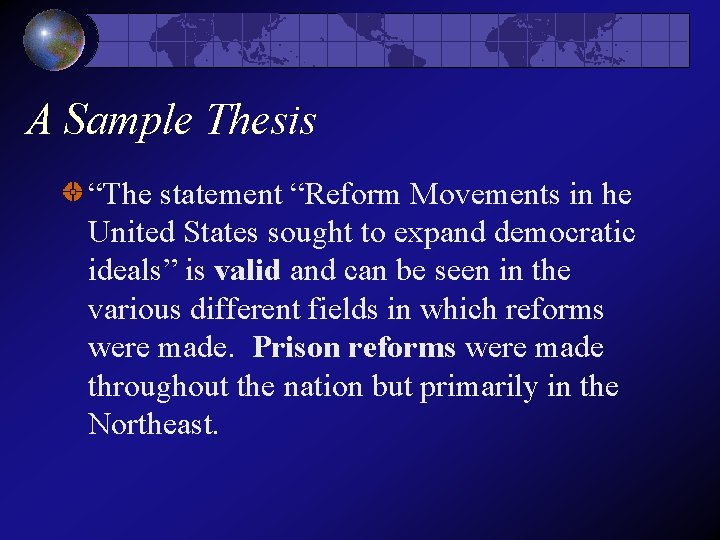
A Sample Thesis “The statement “Reform Movements in he United States sought to expand democratic ideals” is valid and can be seen in the various different fields in which reforms were made. Prison reforms were made throughout the nation but primarily in the Northeast.
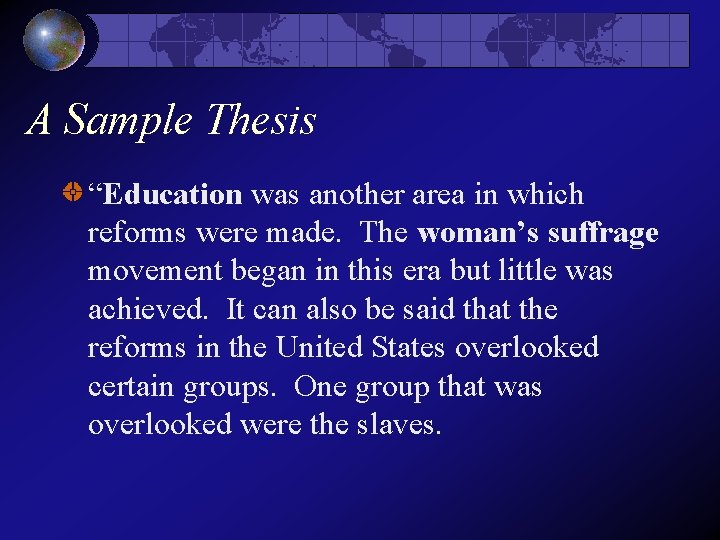
A Sample Thesis “Education was another area in which reforms were made. The woman’s suffrage movement began in this era but little was achieved. It can also be said that the reforms in the United States overlooked certain groups. One group that was overlooked were the slaves.
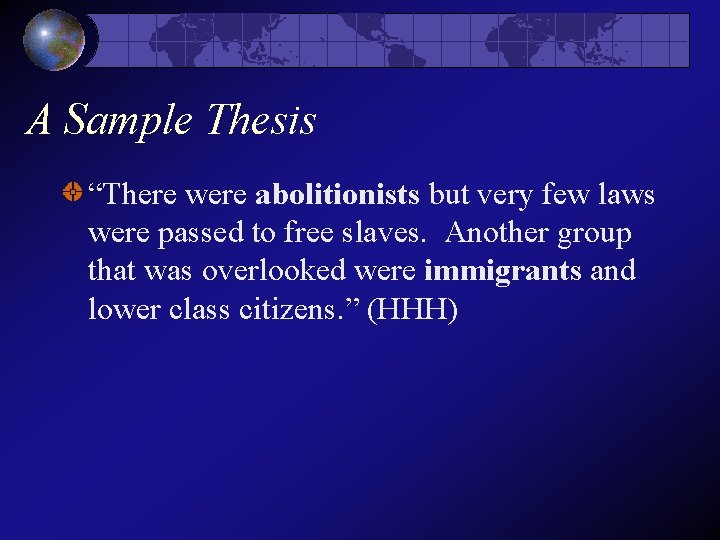
A Sample Thesis “There were abolitionists but very few laws were passed to free slaves. Another group that was overlooked were immigrants and lower class citizens. ” (HHH)
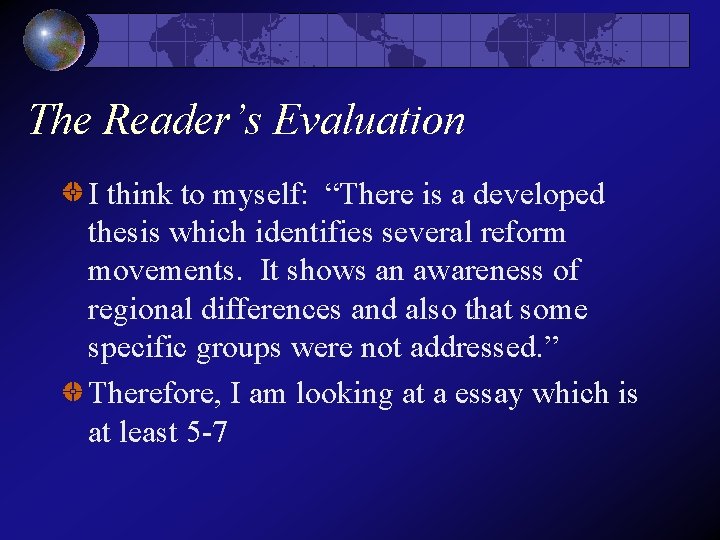
The Reader’s Evaluation I think to myself: “There is a developed thesis which identifies several reform movements. It shows an awareness of regional differences and also that some specific groups were not addressed. ” Therefore, I am looking at a essay which is at least 5 -7
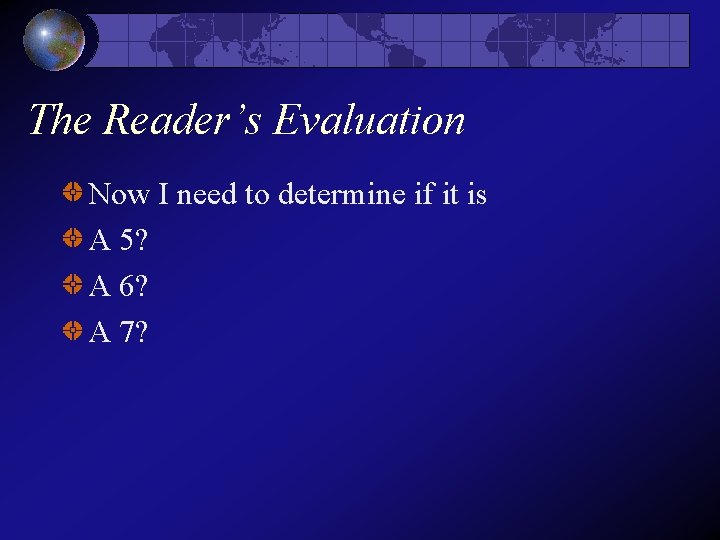
The Reader’s Evaluation Now I need to determine if it is A 5? A 6? A 7?
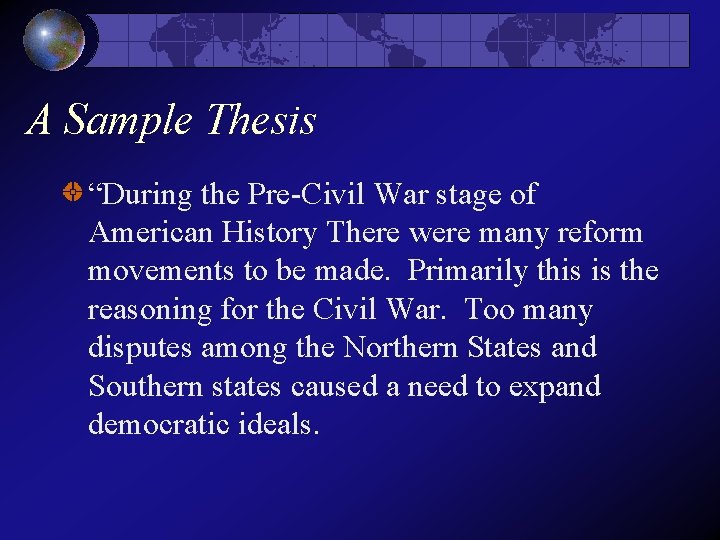
A Sample Thesis “During the Pre-Civil War stage of American History There were many reform movements to be made. Primarily this is the reasoning for the Civil War. Too many disputes among the Northern States and Southern states caused a need to expand democratic ideals.
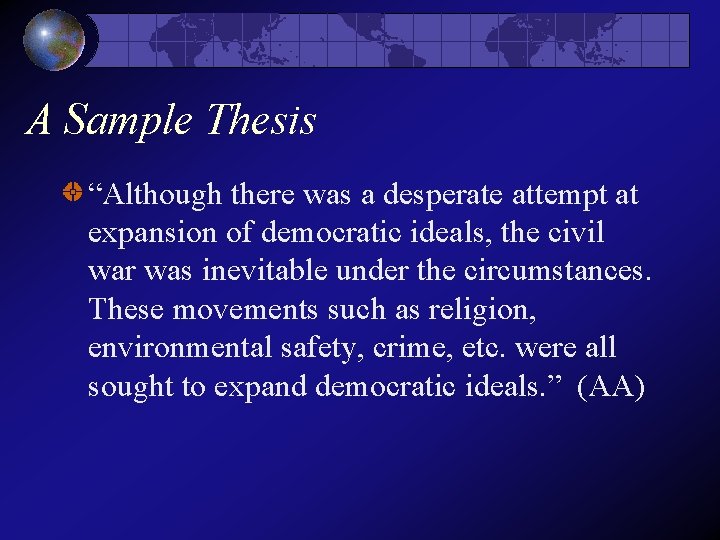
A Sample Thesis “Although there was a desperate attempt at expansion of democratic ideals, the civil war was inevitable under the circumstances. These movements such as religion, environmental safety, crime, etc. were all sought to expand democratic ideals. ” (AA)
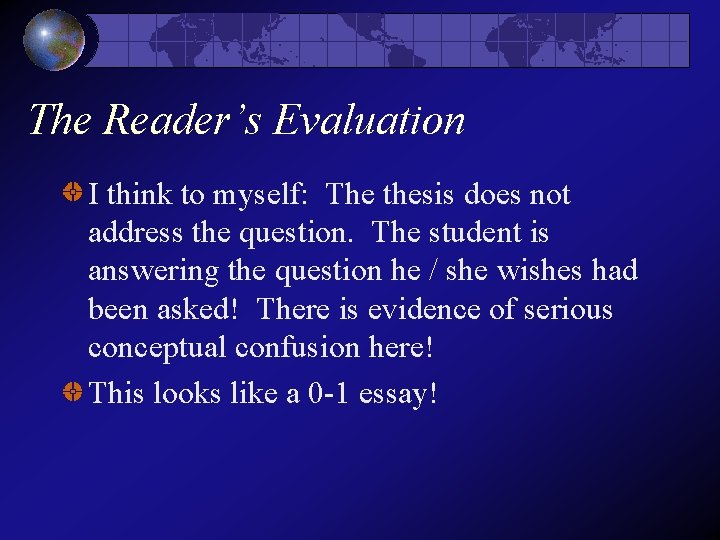
The Reader’s Evaluation I think to myself: The thesis does not address the question. The student is answering the question he / she wishes had been asked! There is evidence of serious conceptual confusion here! This looks like a 0 -1 essay!
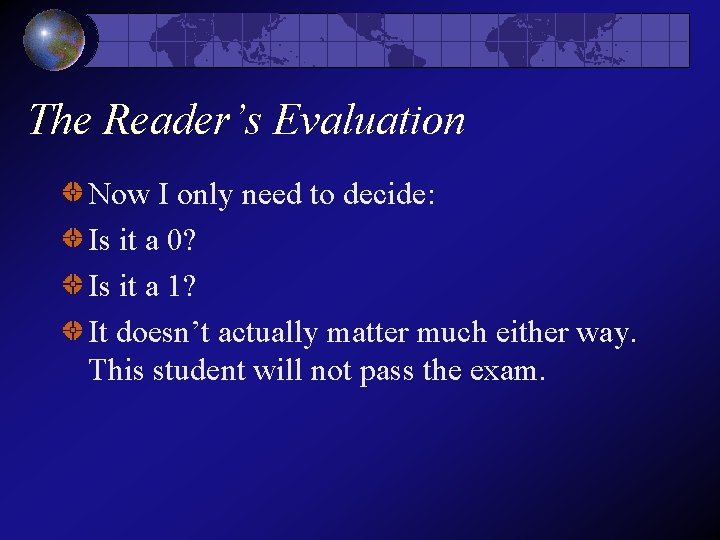
The Reader’s Evaluation Now I only need to decide: Is it a 0? Is it a 1? It doesn’t actually matter much either way. This student will not pass the exam.
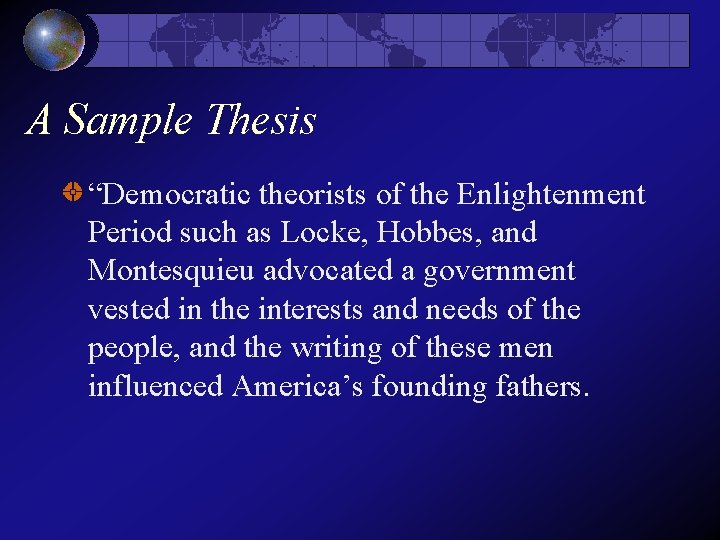
A Sample Thesis “Democratic theorists of the Enlightenment Period such as Locke, Hobbes, and Montesquieu advocated a government vested in the interests and needs of the people, and the writing of these men influenced America’s founding fathers.
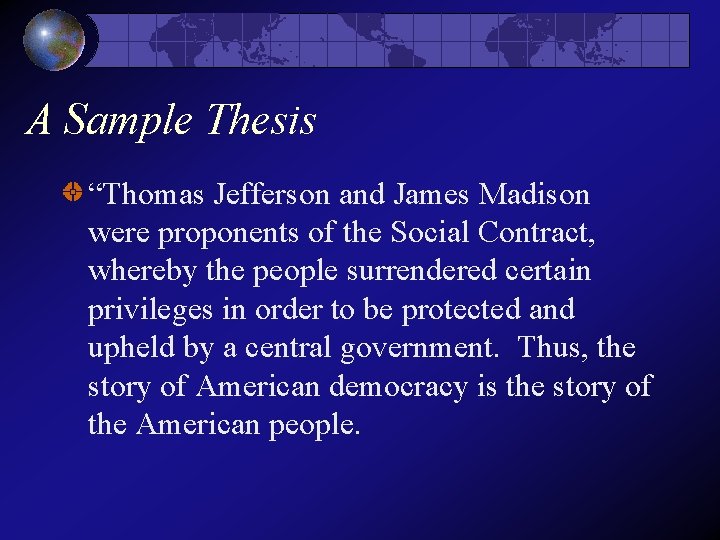
A Sample Thesis “Thomas Jefferson and James Madison were proponents of the Social Contract, whereby the people surrendered certain privileges in order to be protected and upheld by a central government. Thus, the story of American democracy is the story of the American people.
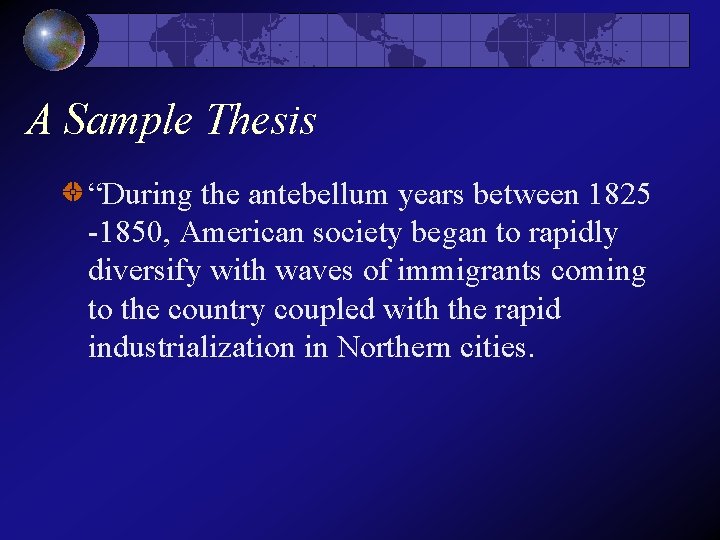
A Sample Thesis “During the antebellum years between 1825 -1850, American society began to rapidly diversify with waves of immigrants coming to the country coupled with the rapid industrialization in Northern cities.
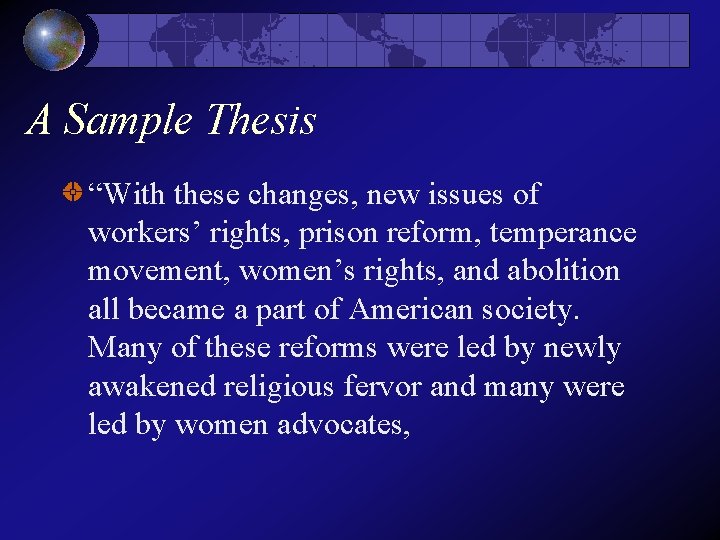
A Sample Thesis “With these changes, new issues of workers’ rights, prison reform, temperance movement, women’s rights, and abolition all became a part of American society. Many of these reforms were led by newly awakened religious fervor and many were led by women advocates,
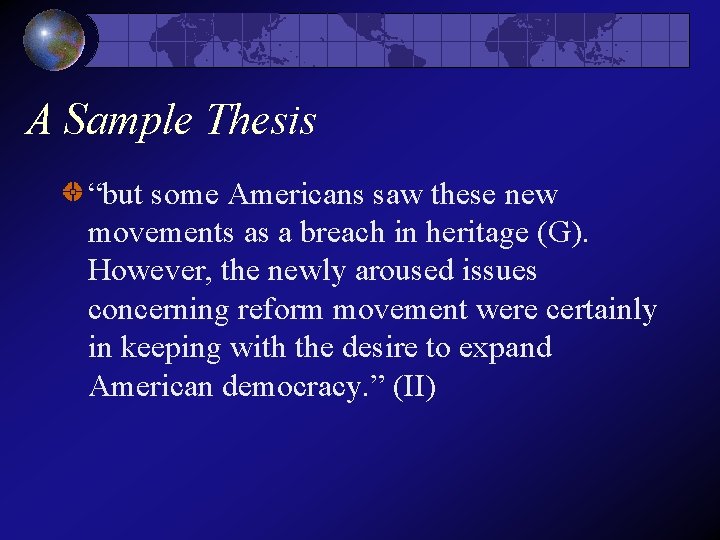
A Sample Thesis “but some Americans saw these new movements as a breach in heritage (G). However, the newly aroused issues concerning reform movement were certainly in keeping with the desire to expand American democracy. ” (II)
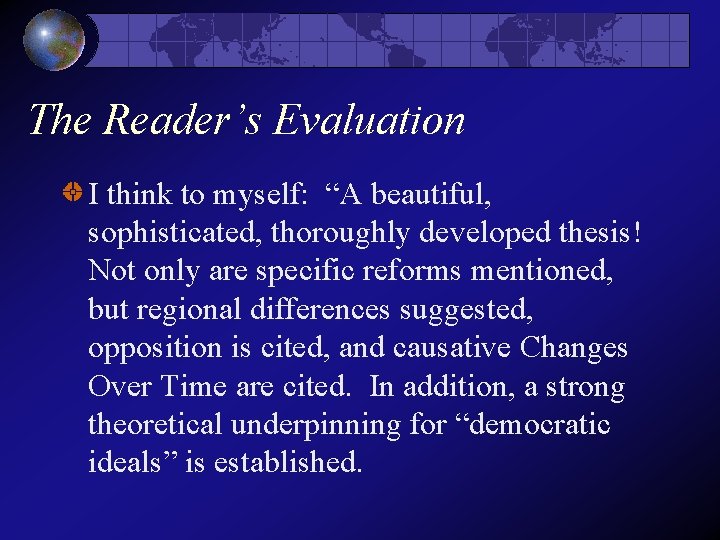
The Reader’s Evaluation I think to myself: “A beautiful, sophisticated, thoroughly developed thesis! Not only are specific reforms mentioned, but regional differences suggested, opposition is cited, and causative Changes Over Time are cited. In addition, a strong theoretical underpinning for “democratic ideals” is established.
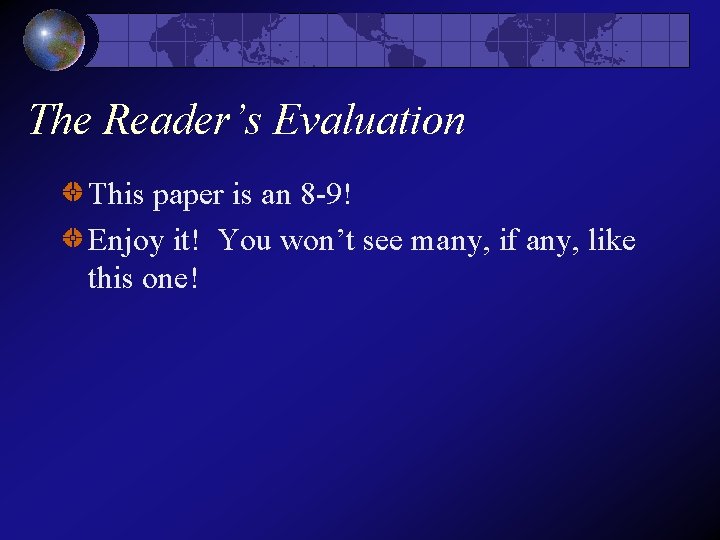
The Reader’s Evaluation This paper is an 8 -9! Enjoy it! You won’t see many, if any, like this one!
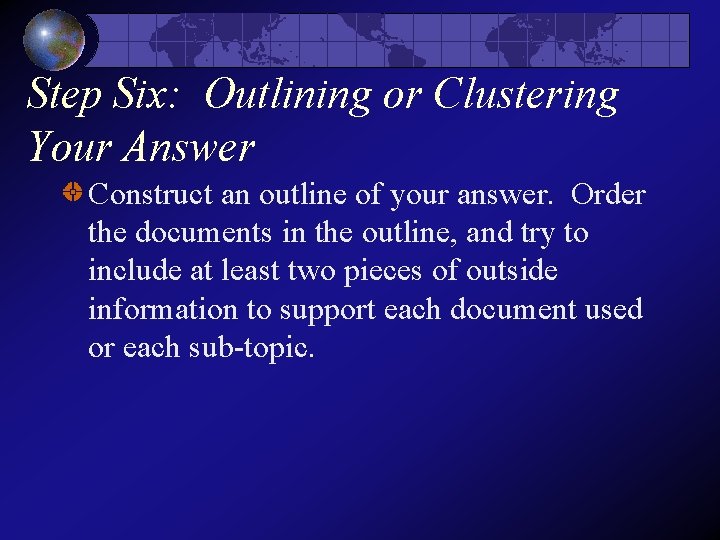
Step Six: Outlining or Clustering Your Answer Construct an outline of your answer. Order the documents in the outline, and try to include at least two pieces of outside information to support each document used or each sub-topic.
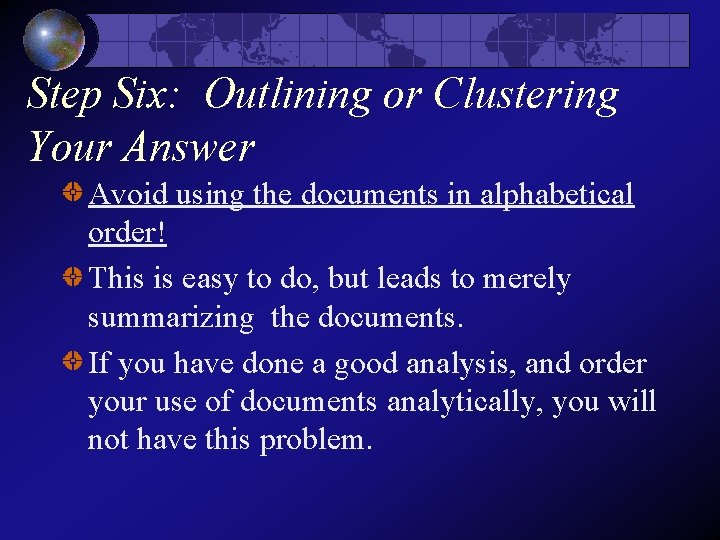
Step Six: Outlining or Clustering Your Answer Avoid using the documents in alphabetical order! This is easy to do, but leads to merely summarizing the documents. If you have done a good analysis, and order your use of documents analytically, you will not have this problem.
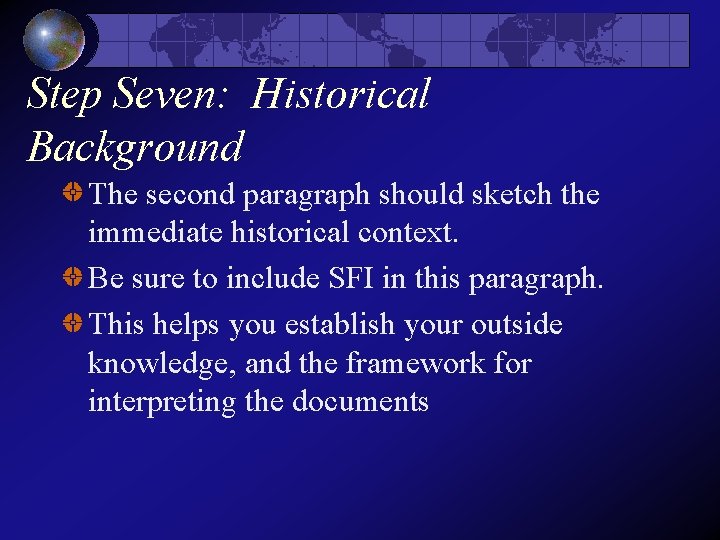
Step Seven: Historical Background The second paragraph should sketch the immediate historical context. Be sure to include SFI in this paragraph. This helps you establish your outside knowledge, and the framework for interpreting the documents
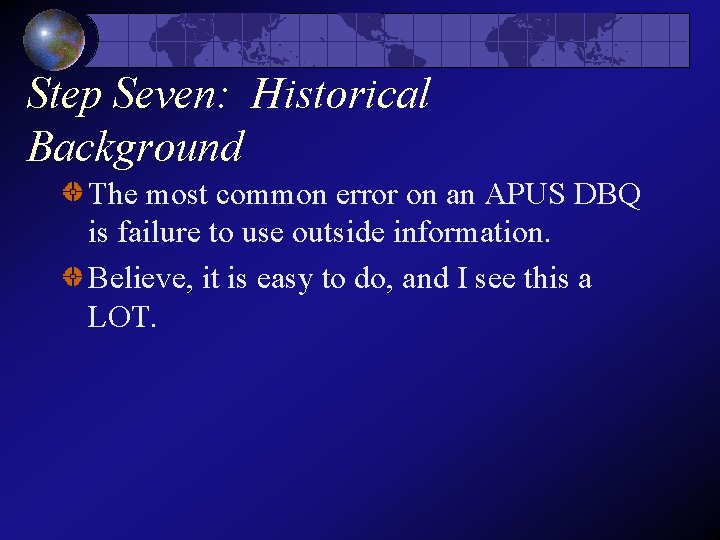
Step Seven: Historical Background The most common error on an APUS DBQ is failure to use outside information. Believe, it is easy to do, and I see this a LOT.
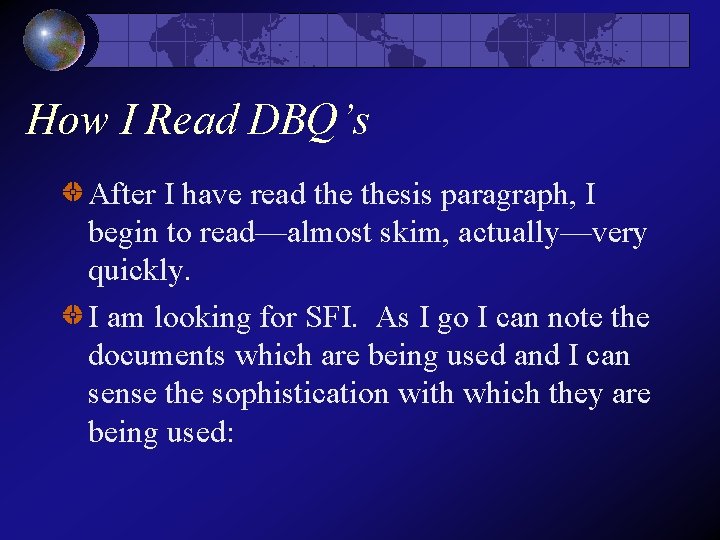
How I Read DBQ’s After I have read thesis paragraph, I begin to read—almost skim, actually—very quickly. I am looking for SFI. As I go I can note the documents which are being used and I can sense the sophistication with which they are being used:
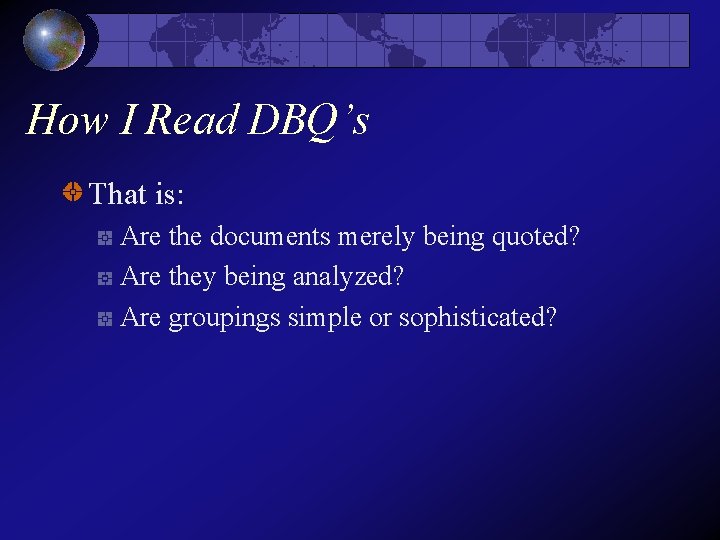
How I Read DBQ’s That is: Are the documents merely being quoted? Are they being analyzed? Are groupings simple or sophisticated?
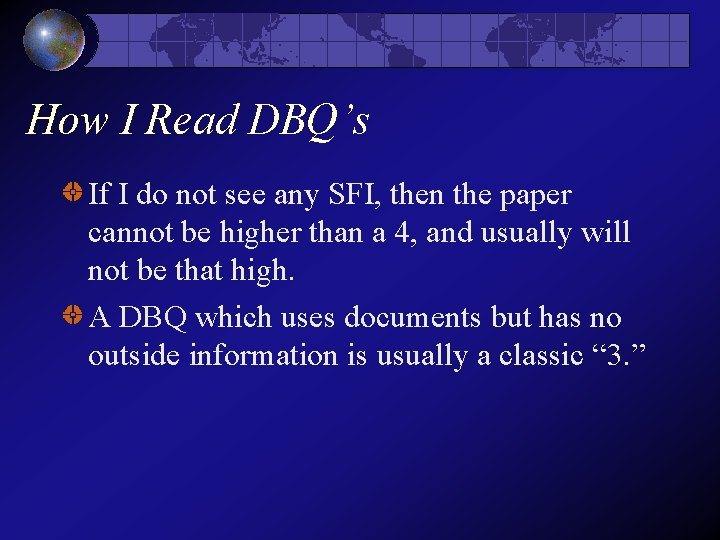
How I Read DBQ’s If I do not see any SFI, then the paper cannot be higher than a 4, and usually will not be that high. A DBQ which uses documents but has no outside information is usually a classic “ 3. ”
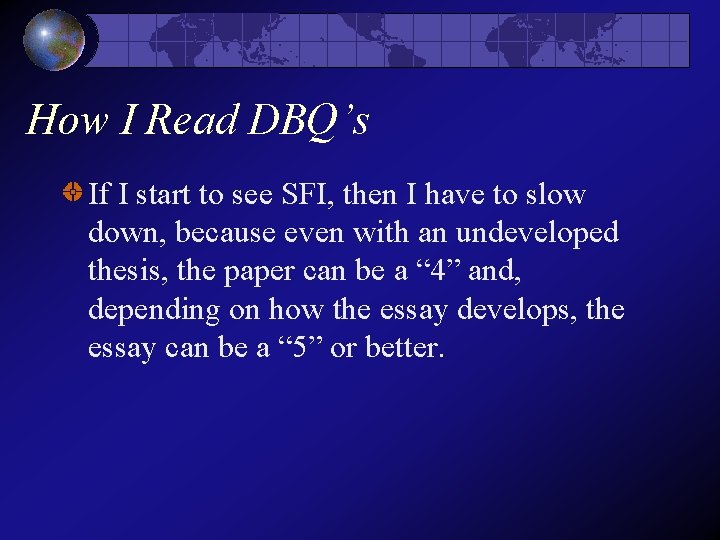
How I Read DBQ’s If I start to see SFI, then I have to slow down, because even with an undeveloped thesis, the paper can be a “ 4” and, depending on how the essay develops, the essay can be a “ 5” or better.
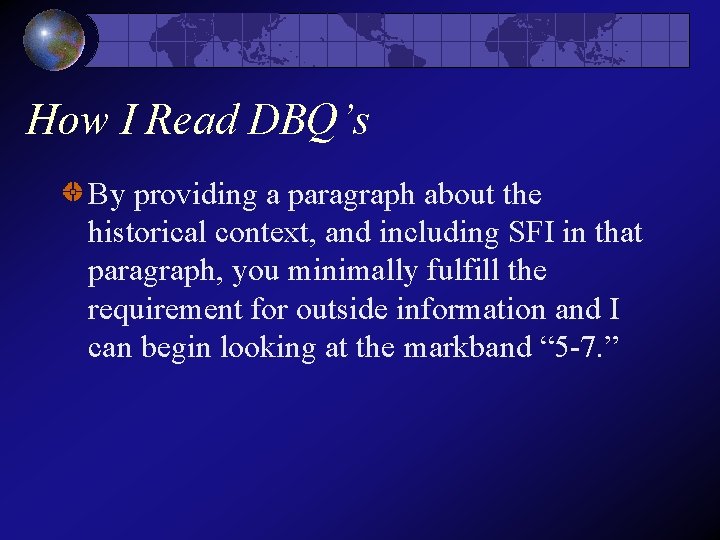
How I Read DBQ’s By providing a paragraph about the historical context, and including SFI in that paragraph, you minimally fulfill the requirement for outside information and I can begin looking at the markband “ 5 -7. ”
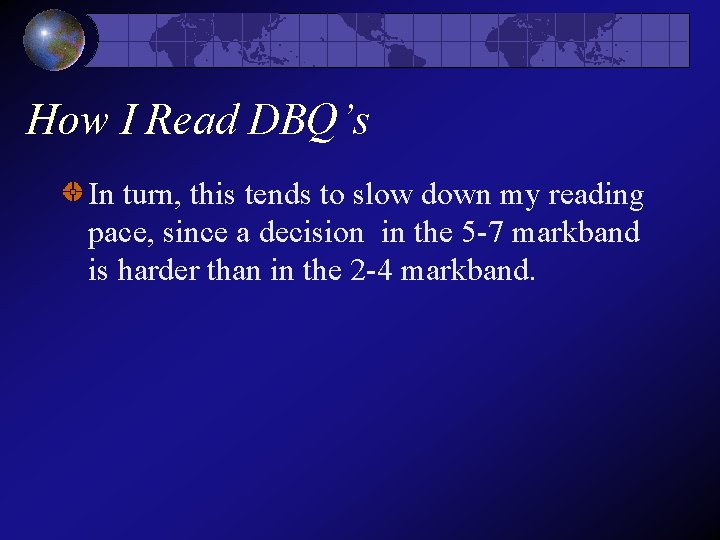
How I Read DBQ’s In turn, this tends to slow down my reading pace, since a decision in the 5 -7 markband is harder than in the 2 -4 markband.
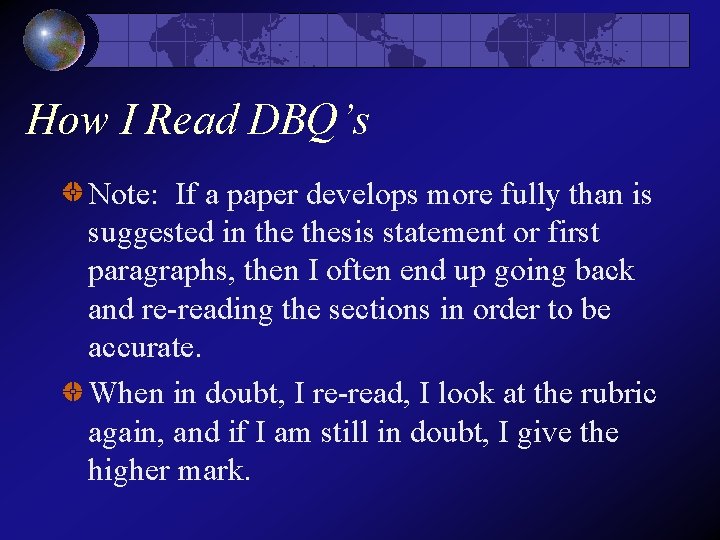
How I Read DBQ’s Note: If a paper develops more fully than is suggested in thesis statement or first paragraphs, then I often end up going back and re-reading the sections in order to be accurate. When in doubt, I re-read, I look at the rubric again, and if I am still in doubt, I give the higher mark.
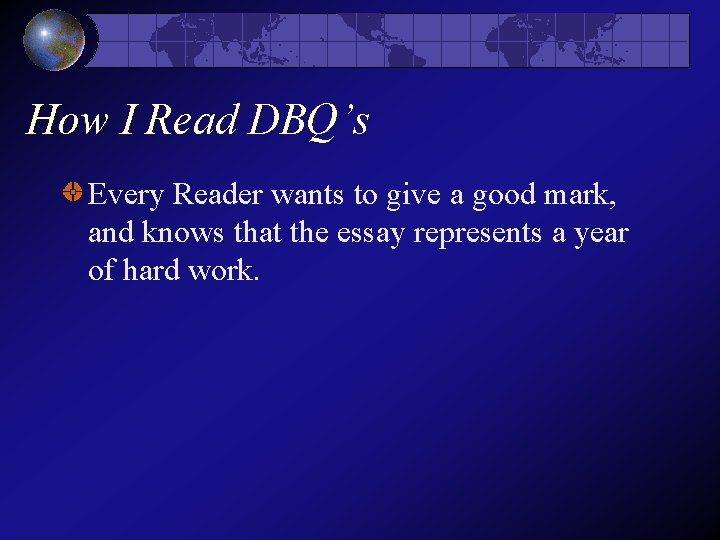
How I Read DBQ’s Every Reader wants to give a good mark, and knows that the essay represents a year of hard work.
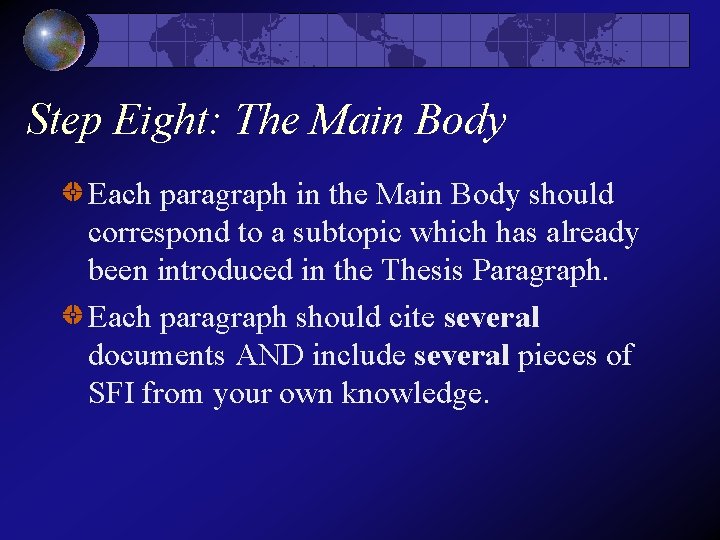
Step Eight: The Main Body Each paragraph in the Main Body should correspond to a subtopic which has already been introduced in the Thesis Paragraph. Each paragraph should cite several documents AND include several pieces of SFI from your own knowledge.
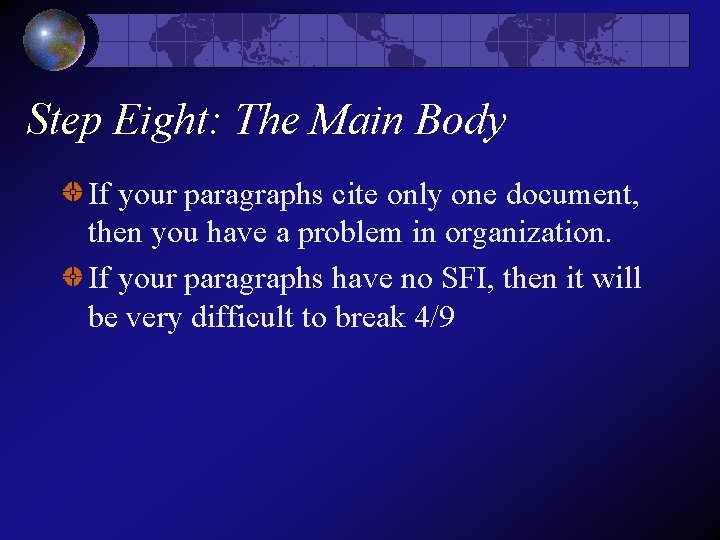
Step Eight: The Main Body If your paragraphs cite only one document, then you have a problem in organization. If your paragraphs have no SFI, then it will be very difficult to break 4/9
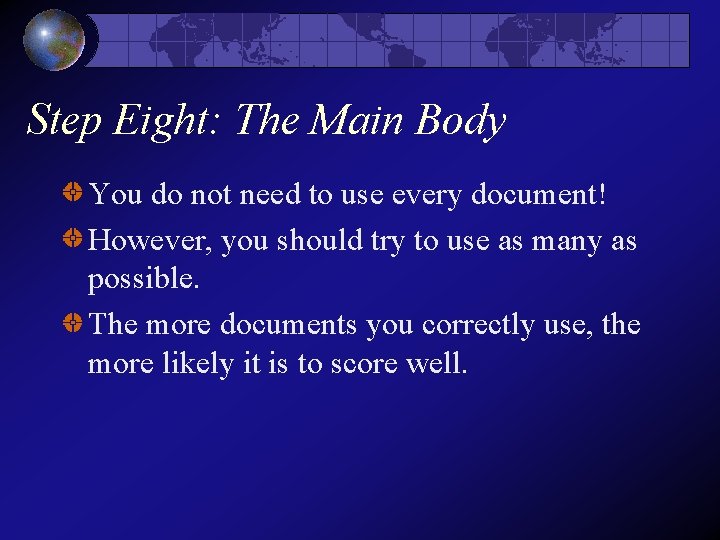
Step Eight: The Main Body You do not need to use every document! However, you should try to use as many as possible. The more documents you correctly use, the more likely it is to score well.
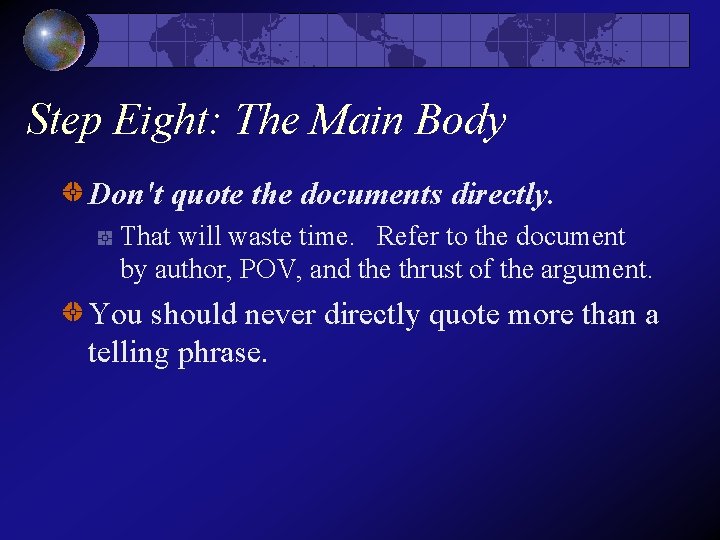
Step Eight: The Main Body Don't quote the documents directly. That will waste time. Refer to the document by author, POV, and the thrust of the argument. You should never directly quote more than a telling phrase.
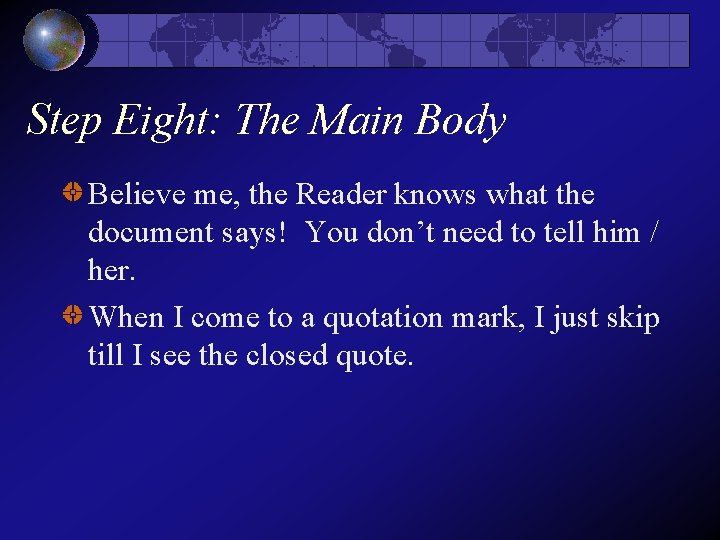
Step Eight: The Main Body Believe me, the Reader knows what the document says! You don’t need to tell him / her. When I come to a quotation mark, I just skip till I see the closed quote.
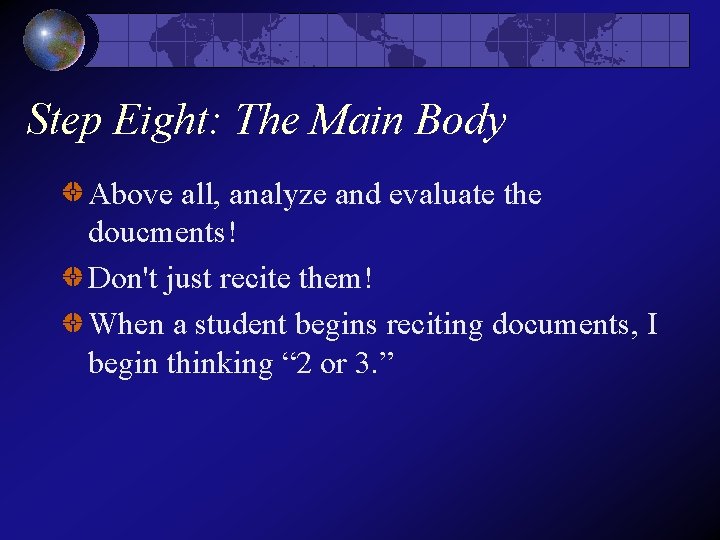
Step Eight: The Main Body Above all, analyze and evaluate the doucments! Don't just recite them! When a student begins reciting documents, I begin thinking “ 2 or 3. ”
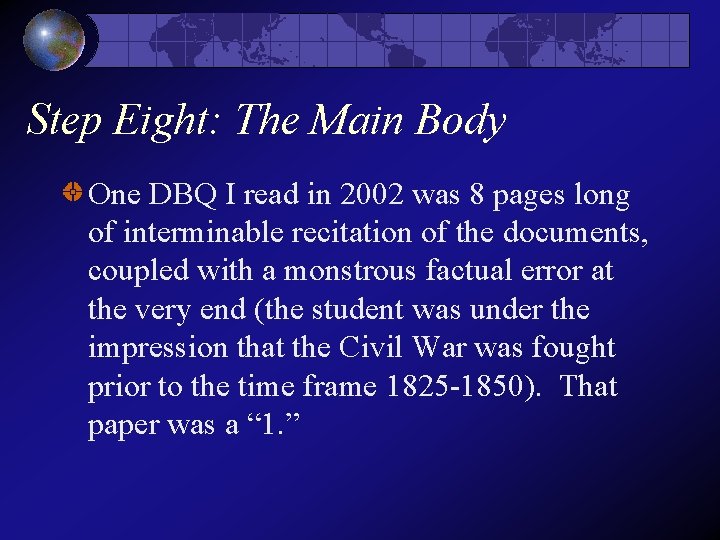
Step Eight: The Main Body One DBQ I read in 2002 was 8 pages long of interminable recitation of the documents, coupled with a monstrous factual error at the very end (the student was under the impression that the Civil War was fought prior to the time frame 1825 -1850). That paper was a “ 1. ”
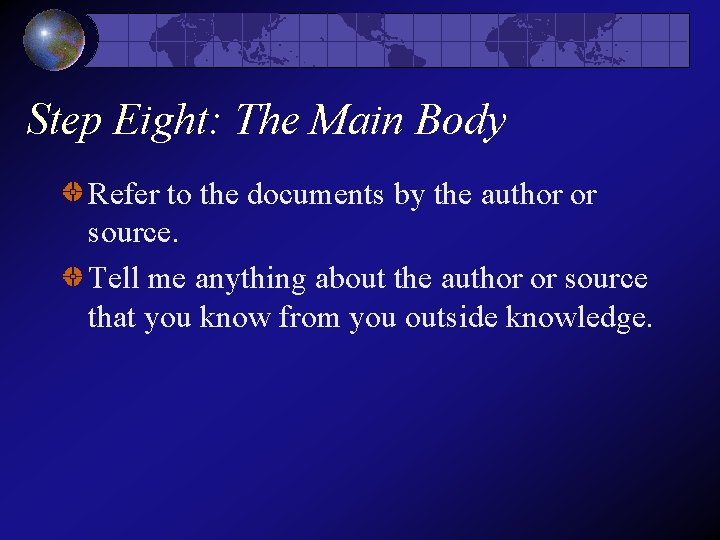
Step Eight: The Main Body Refer to the documents by the author or source. Tell me anything about the author or source that you know from you outside knowledge.
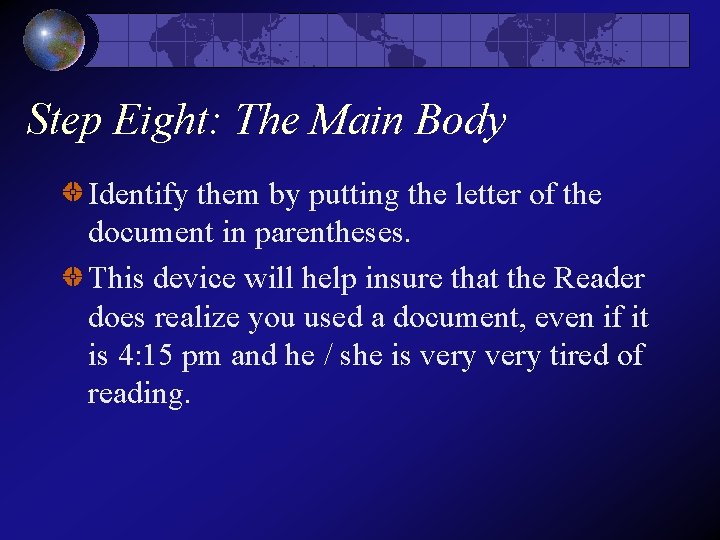
Step Eight: The Main Body Identify them by putting the letter of the document in parentheses. This device will help insure that the Reader does realize you used a document, even if it is 4: 15 pm and he / she is very tired of reading.
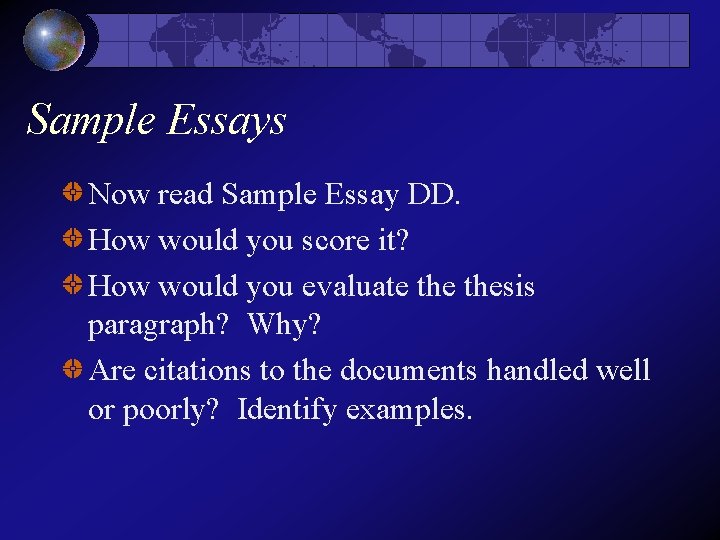
Sample Essays Now read Sample Essay DD. How would you score it? How would you evaluate thesis paragraph? Why? Are citations to the documents handled well or poorly? Identify examples.
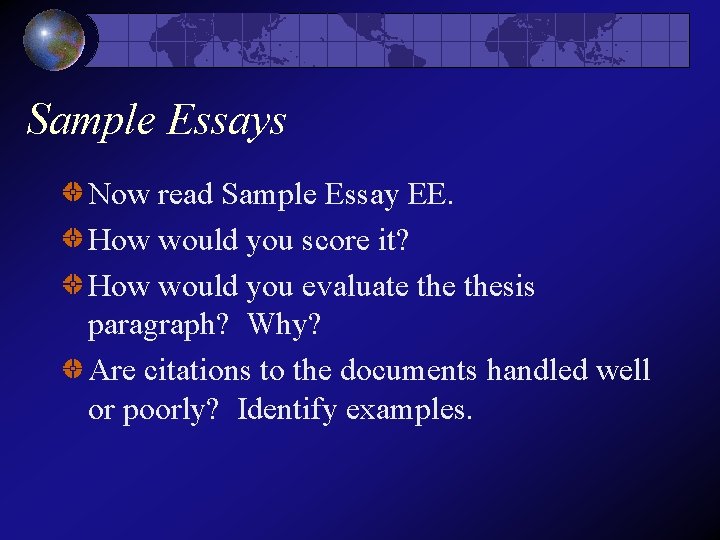
Sample Essays Now read Sample Essay EE. How would you score it? How would you evaluate thesis paragraph? Why? Are citations to the documents handled well or poorly? Identify examples.
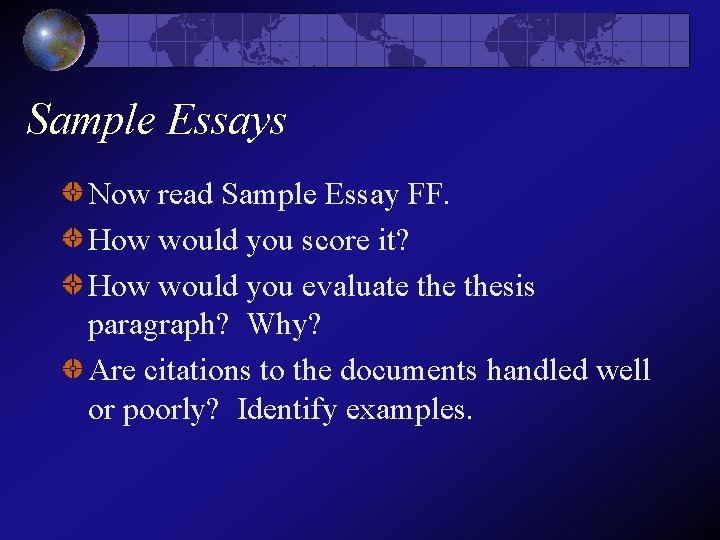
Sample Essays Now read Sample Essay FF. How would you score it? How would you evaluate thesis paragraph? Why? Are citations to the documents handled well or poorly? Identify examples.
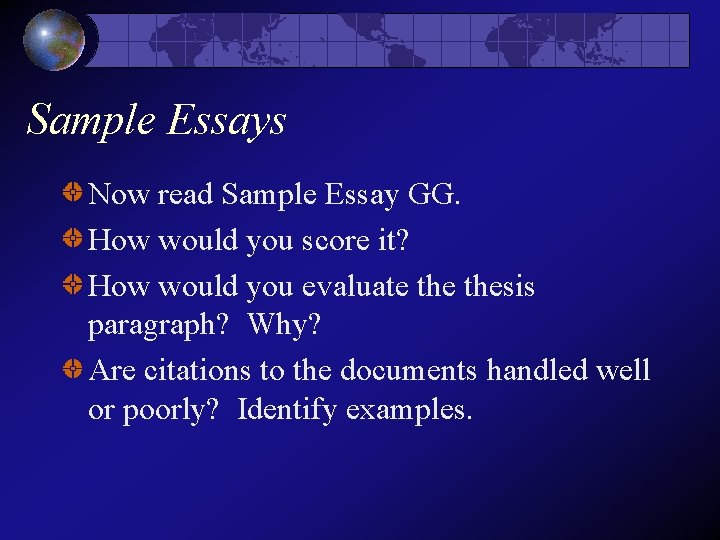
Sample Essays Now read Sample Essay GG. How would you score it? How would you evaluate thesis paragraph? Why? Are citations to the documents handled well or poorly? Identify examples.
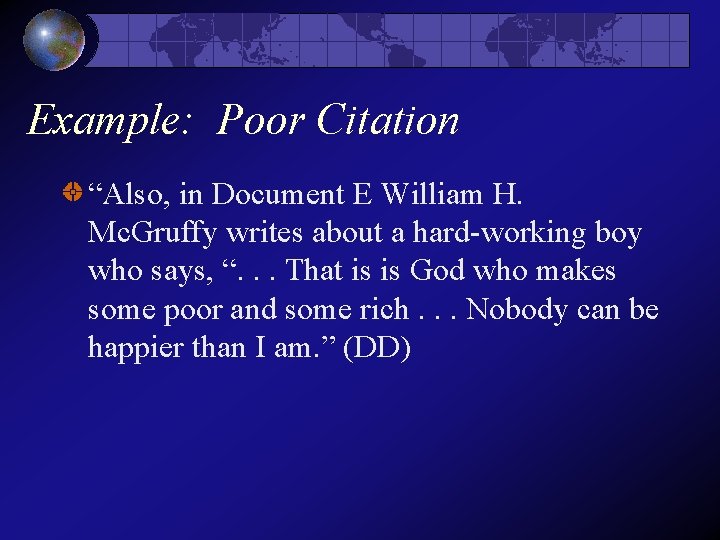
Example: Poor Citation “Also, in Document E William H. Mc. Gruffy writes about a hard-working boy who says, “. . . That is is God who makes some poor and some rich. . . Nobody can be happier than I am. ” (DD)
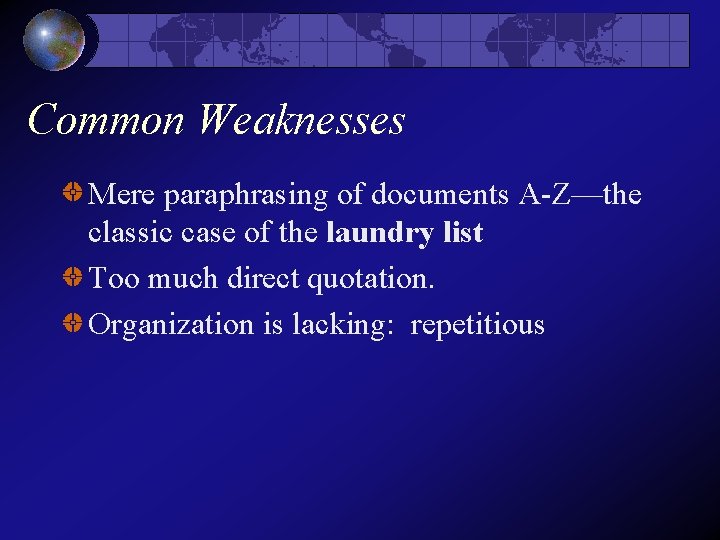
Common Weaknesses Mere paraphrasing of documents A-Z—the classic case of the laundry list Too much direct quotation. Organization is lacking: repetitious
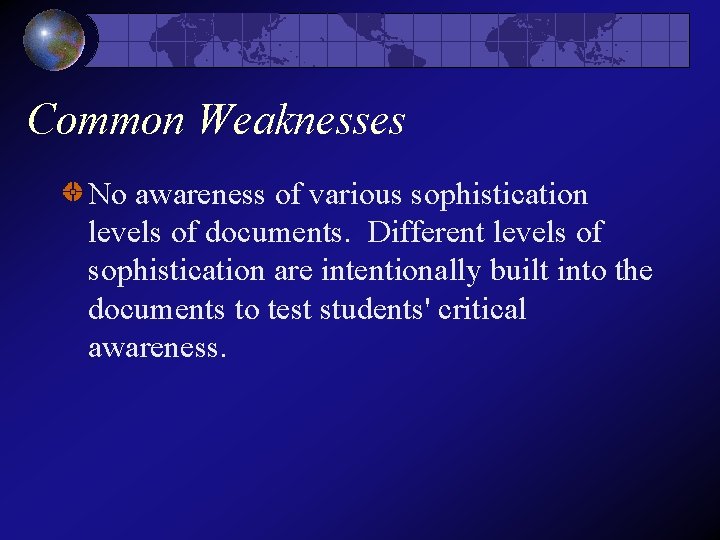
Common Weaknesses No awareness of various sophistication levels of documents. Different levels of sophistication are intentionally built into the documents to test students' critical awareness.
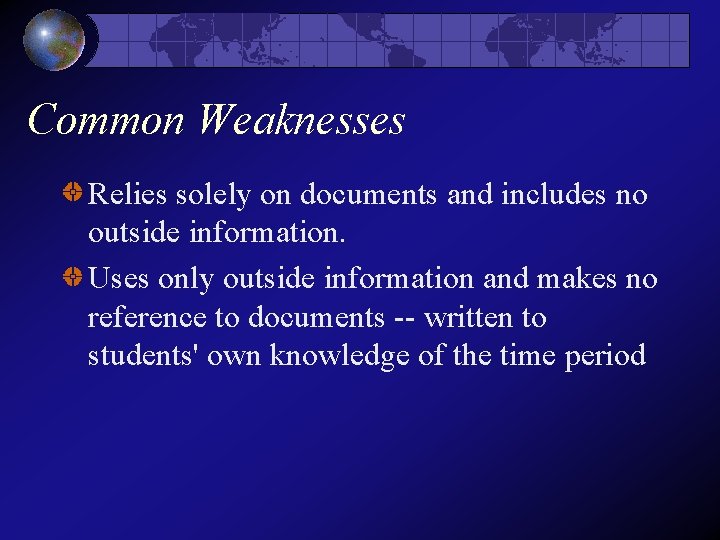
Common Weaknesses Relies solely on documents and includes no outside information. Uses only outside information and makes no reference to documents -- written to students' own knowledge of the time period
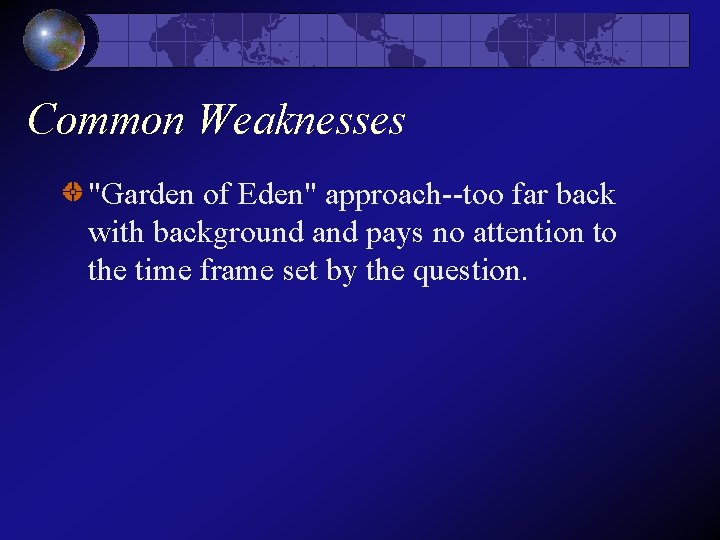
Common Weaknesses "Garden of Eden" approach--too far back with background and pays no attention to the time frame set by the question.
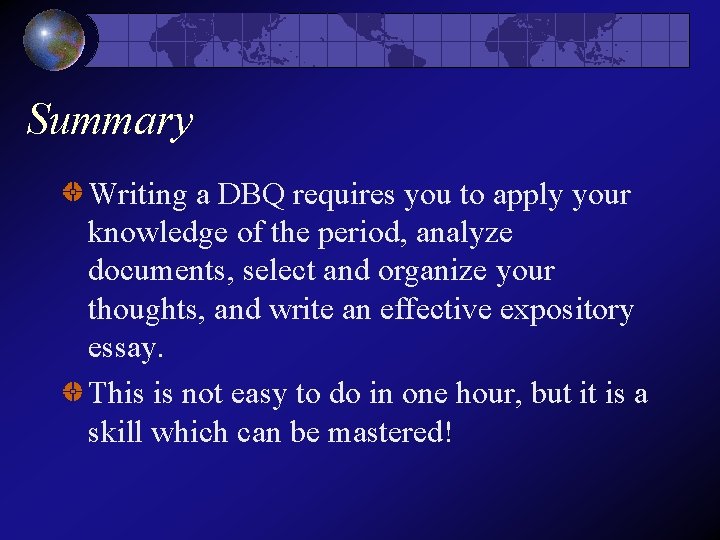
Summary Writing a DBQ requires you to apply your knowledge of the period, analyze documents, select and organize your thoughts, and write an effective expository essay. This is not easy to do in one hour, but it is a skill which can be mastered!
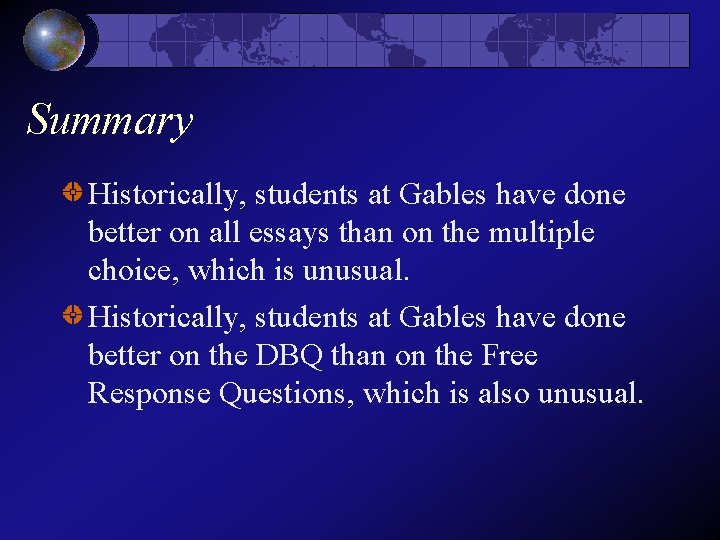
Summary Historically, students at Gables have done better on all essays than on the multiple choice, which is unusual. Historically, students at Gables have done better on the DBQ than on the Free Response Questions, which is also unusual.
- Slides: 160